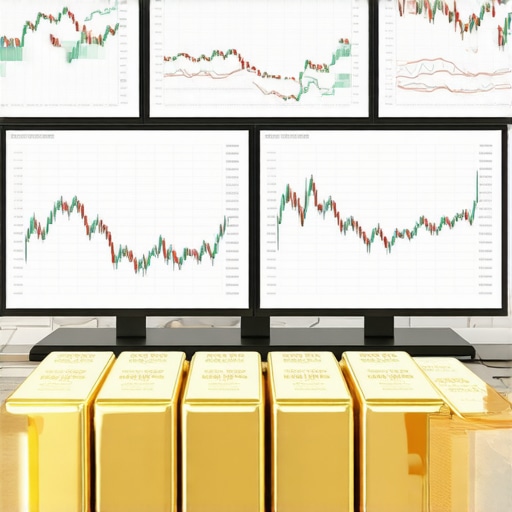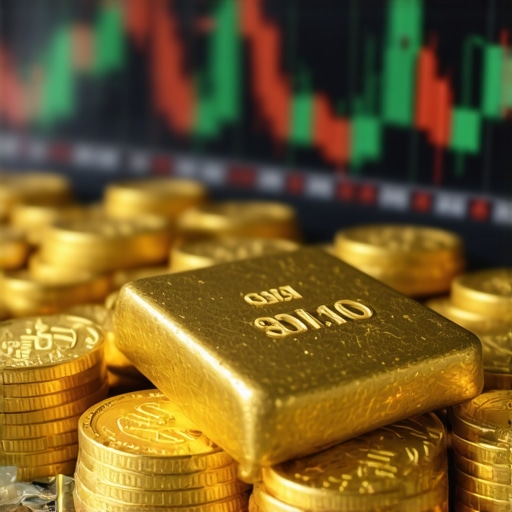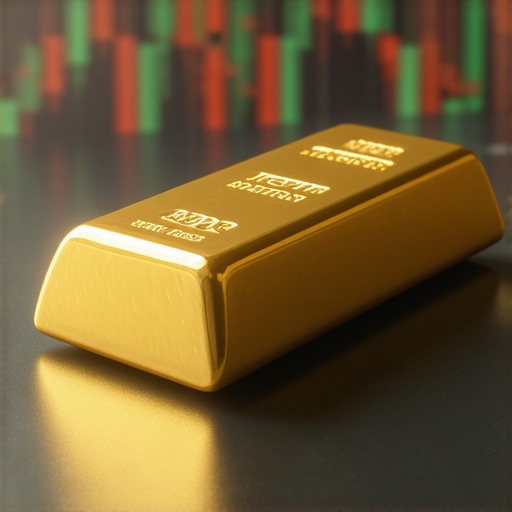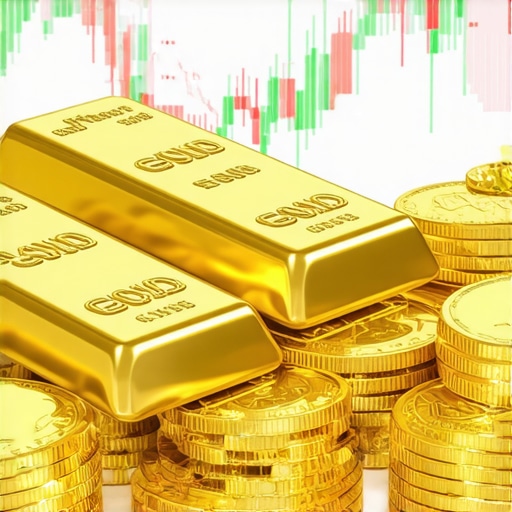Unlocking the Crystal Ball: What Drives Gold Prices in 2025?
As we approach 2025, investors and market watchers are keenly assessing the gold price forecast to navigate an increasingly complex economic landscape. Gold has long been a refuge amid financial uncertainty, yet the dynamics influencing its valuation evolve continuously. Understanding these key economic drivers not only sharpens investment strategies but also reveals the deeper interplay between global markets, monetary policies, and geopolitical shifts.
Global Inflation Trends: The Silent Catalyst Behind Gold’s Surge
Inflation remains one of the most potent forces swaying gold prices. Historically, rising inflation erodes fiat currency value, compelling investors to seek gold as a protective hedge. In 2025, inflationary pressures are expected to persist due to ongoing supply chain disruptions and expansive fiscal policies worldwide. This environment amplifies gold’s appeal as a store of value, often leading to upward price momentum.
Central Banks’ Gold Purchases: A Strategic Game Changer
Central banks play a pivotal role in shaping the gold market by adjusting their reserves. Recent trends show significant gold acquisitions by major economies aiming to diversify away from traditional reserve currencies. For instance, countries like China and India have been steadily increasing their gold holdings, signaling confidence in gold’s long-term stability. This strategic accumulation directly bolsters demand and can act as a bullish indicator for 2025 prices. For deeper insights, explore how central bank gold purchases influence global prices.
Market Volatility and Safe-Haven Demand: Why Gold Remains Irreplaceable
Heightened geopolitical tensions and unpredictable financial markets often drive investors toward gold’s safe-haven status. Episodes of market turbulence, such as currency fluctuations or international conflicts, typically trigger spikes in gold buying. The year 2025 is shaping up to be no exception, with economic recovery uncertainties and varying monetary tightening cycles across regions. This environment underscores gold’s role as a reliable asset to stabilize portfolios during volatility.
How Do Supply and Demand Dynamics Affect Gold Price Forecasts?
The balance between gold supply and demand is fundamental yet nuanced. Mining output constraints, coupled with surging consumer demand—especially from emerging markets—can create tight supply conditions that elevate prices. Additionally, the growth of gold-backed ETFs and increased industrial usage further intensify demand. Understanding these market forces is crucial for anticipating price fluctuations. Detailed analysis can be found in gold supply and demand essential insights.
Engage with this evolving market by sharing your thoughts or questions below, and explore more expert perspectives on key factors impacting gold market value in 2025.
Source: World Gold Council – Gold Demand Trends 2024 Report
Personal Lessons from Gold Investing in Uncertain Times
Reflecting on my own journey with gold investments, I’ve learned how vital it is to adapt strategies as economic landscapes shift. For example, during periods when inflation spikes unexpectedly, I’ve found that reallocating a portion of my portfolio into physical gold or gold ETFs can provide a reassuring hedge against currency devaluation. It’s not just about owning gold but choosing the right form—whether bars, coins, or ETFs—that aligns with your investment goals and risk tolerance.
One particular experience stands out: during a recent phase of market volatility, I shifted some holdings into gold mutual funds. This approach offered diversification and professional management, which helped me feel more secure without the hassle of physical storage. If you’re curious about this option, the beginners guide to gold mutual funds is a great resource to start with.
Timing and Patience: The Twin Pillars of Successful Gold Investment
Gold isn’t a get-rich-quick asset. From my experience, it requires a patient mindset. You might notice short-term price swings, but over time, the underlying value tends to hold firm, especially when backed by economic indicators like inflation and central bank actions. Learning to resist the urge to react hastily has been a key takeaway. Instead, I monitor market trends and forecasts carefully, such as those that analyze key economic drivers for 2025, before making decisions.
Ever Wondered How to Choose Between Physical Gold and Gold ETFs?
This question has come up often in my conversations with fellow investors. Physical gold offers tangible security but demands safe storage and insurance. Gold ETFs, on the other hand, provide liquidity and ease of trading without physical handling. Your choice depends largely on your investment horizon, comfort with market volatility, and logistical preferences.
Interestingly, recent studies, including insights from the World Gold Council, show that gold-backed ETFs have seen increased inflows in times of economic uncertainty, reflecting investors’ preference for flexibility alongside safety. This highlights the evolving nature of gold as both a traditional and modern asset class.
Have you experimented with different types of gold investments? Feel free to share your experiences or questions below! For more practical tips on safe and smart gold purchases, check out the article on best practices for buying physical gold bars.
Decoding the Influence of Currency Fluctuations on Gold Valuation in 2025
Currency exchange rate volatility remains a critical yet often underappreciated factor in gold price movements. Since gold is priced predominantly in US dollars, any depreciation of the dollar typically inflates gold prices for holders of other currencies, enhancing global demand. Conversely, a strong dollar can suppress gold prices by making it more expensive in other currencies. However, in 2025, the scenario is more intricate due to divergent monetary policies across major economies.
For instance, while the US Federal Reserve may adopt a hawkish stance to tame inflation, the European Central Bank or Bank of Japan might maintain or even ease policies, influencing relative currency strengths and investor sentiment. This mosaic of monetary decisions creates complex arbitrage opportunities and hedging behaviors in the gold market. Investors monitoring these currency dynamics can better anticipate short-term price oscillations beyond traditional inflation or geopolitical narratives.
Technological Innovations in Gold Mining: Impact on Supply and Market Stability
Mining technology advancements are reshaping the gold supply landscape, with cutting-edge extraction methods and AI-driven resource identification optimizing yield and reducing operational costs. These innovations can gradually ease supply constraints that historically drove price spikes, but their deployment timelines and geopolitical risks in mining regions temper immediate impacts.
Moreover, sustainable mining practices and stricter environmental regulations are influencing production strategies, potentially limiting output growth despite technological gains. This juxtaposition introduces a nuanced dynamic where supply-side improvements coexist with regulatory and social pressures, maintaining a delicate equilibrium that investors must analyze carefully when forecasting gold prices.
How Does the Rising Popularity of Digital Gold Tokens Affect Traditional Gold Investment?
The emergence of blockchain-based digital gold tokens presents a transformative frontier for gold investment, blending traditional asset security with modern liquidity and accessibility. Digital tokens represent ownership of physical gold stored securely, allowing fractional investment and instantaneous trading on decentralized platforms.
This innovation democratizes gold investment and potentially increases market participation, especially among younger, tech-savvy demographics. However, it also introduces regulatory uncertainties and custodial risks that differ markedly from physical gold or ETFs. Understanding this evolving asset class is essential for sophisticated investors seeking to diversify their portfolios while navigating emerging market regulations. The Investopedia resource on digital gold tokens offers a comprehensive overview of this trend.
Exploring these advanced dimensions of gold investment can enrich your strategy significantly. Feel free to engage further by sharing your perspectives or inquiries below. For those eager to delve deeper, our upcoming analysis on advanced gold investment strategies in 2025 will provide expert-level guidance tailored to current market complexities.
Geopolitical Risk Premiums: Quantifying Their Subtle Yet Potent Influence on Gold Pricing
Beyond headline geopolitical events, the nuanced calculation of risk premiums profoundly affects gold’s valuation. Sophisticated investors recognize that seemingly minor diplomatic tensions or trade disagreements can preemptively trigger gold price adjustments, as markets price in uncertainty well before manifest crises. This anticipatory behavior is embedded in derivative markets and futures contracts, offering a leading indicator of gold’s trajectory amid global instability.
What Advanced Metrics Best Predict Gold Price Reactions to Geopolitical Shifts?
Expert analysts deploy composite indices combining geopolitical risk scores, volatility indices (VIX), and sovereign credit spreads to forecast gold price sensitivity to geopolitical developments. For example, the Geopolitical Risk Index by the Kiel Institute integrates multifaceted data to quantify risk levels, enabling nuanced modeling of gold price movements. By correlating these indices with historical gold price reactions, investors can refine entry and exit strategies with greater precision.
The Intersection of Environmental, Social, and Governance (ESG) Factors with Gold Investment Viability
ESG considerations are increasingly influencing both mining operations and investor preferences, reshaping the gold market’s ethical landscape. Mining companies adopting sustainable practices tend to attract premium valuations, while investors incorporate ESG scores into asset selection criteria. This paradigm shift not only impacts supply chain transparency but also informs long-term price stability, as regulatory frameworks tighten around environmental compliance and social responsibility.
Simultaneously, ESG-conscious investors are exploring gold-backed funds vetted for responsible sourcing, which may command liquidity premiums. Navigating this evolving terrain necessitates a sophisticated understanding of ESG metrics and their tangible effect on gold’s market dynamics.
Algorithmic Trading and AI: Transforming Gold Market Liquidity and Volatility Patterns
The proliferation of algorithmic trading and artificial intelligence has introduced new layers of complexity to gold price behavior. High-frequency trading strategies can amplify short-term volatility, while AI-driven predictive models enable large institutional investors to anticipate price swings with unprecedented accuracy.
These technologies also facilitate dynamic hedging and arbitrage across global exchanges, enhancing liquidity but occasionally triggering flash crashes or rapid corrections. Mastery of these phenomena requires integrating quantitative analytics with traditional fundamental analysis, elevating the sophistication of gold market engagement.
Harnessing Behavioral Finance Insights to Optimize Gold Investment Outcomes
Investor psychology significantly influences gold price cycles, often deviating from purely rational valuation models. Behavioral finance research reveals patterns such as herd behavior, loss aversion, and overconfidence that can precipitate price overshooting or prolonged corrections.
By incorporating sentiment analysis tools and monitoring social media trends, advanced investors can detect early signals of market euphoria or panic, enabling timely portfolio adjustments that capitalize on or mitigate these behavioral biases.
For an authoritative exploration of these psychological factors, refer to the Harvard Business Review’s Behavioral Finance Insights.
Engage with these advanced perspectives to refine your gold investment strategy and join the conversation by sharing your questions or insights below. Stay tuned for upcoming expert analyses delving deeper into quantitative models and ESG integration for 2025.

Frequently Asked Questions (FAQ)
What factors primarily drive gold prices in 2025?
Gold prices in 2025 are influenced by a confluence of factors including persistent inflationary pressures, central banks’ strategic gold purchases, currency exchange rate volatility, geopolitical risk premiums, technological advances in mining, and evolving environmental, social, and governance (ESG) considerations. These elements collectively shape demand and supply dynamics, market sentiment, and liquidity, making gold both a safe haven and a sophisticated investment asset.
How do central bank gold purchases affect the global gold market?
Central banks accumulate gold to diversify reserves away from fiat currencies and mitigate geopolitical and economic risks. Increased buying from major economies like China and India signals confidence in gold’s stability, directly boosting demand and often driving prices upward. These purchases also impact market perceptions, influencing investor behavior and price forecasts.
Why is inflation considered a key catalyst for gold price movements?
Inflation erodes the purchasing power of fiat currencies, prompting investors to seek assets that preserve value. Gold historically serves as an effective hedge against inflation, so rising inflation typically leads to increased demand and higher gold prices. In 2025, ongoing supply chain constraints and fiscal policies are expected to sustain inflationary pressures, reinforcing gold’s appeal.
What role do currency fluctuations play in gold valuation?
Since gold is mainly priced in US dollars, fluctuations in the dollar’s strength influence gold prices globally. A weaker dollar makes gold cheaper in other currencies, boosting international demand and price. Conversely, a stronger dollar can suppress gold prices. Divergent monetary policies among major economies add complexity to this relationship in 2025.
How are technological innovations impacting gold supply and market stability?
Advancements such as AI-driven resource identification and improved extraction technologies enhance mining efficiency and potentially increase supply. However, environmental regulations and sustainable mining practices may limit output growth despite technological gains. This creates a nuanced supply landscape that investors must monitor closely.
What is the significance of digital gold tokens in modern gold investing?
Digital gold tokens represent fractional ownership of physical gold stored securely, traded on blockchain platforms. They democratize access, increase liquidity, and appeal to tech-savvy investors. However, they introduce unique regulatory and custodial risks distinct from traditional physical gold or ETFs, requiring informed consideration.
How do geopolitical risk premiums influence gold prices?
Geopolitical tensions and uncertainties embed risk premiums into gold pricing well before crises fully materialize. Sophisticated investors use composite indices measuring geopolitical risks, volatility, and credit spreads to anticipate gold price reactions, enabling more precise investment timing and risk management.
Why are ESG factors becoming important in gold investment?
ESG considerations affect both mining companies’ operations and investors’ asset choices. Sustainable and socially responsible mining practices attract premium valuations and influence long-term price stability. Investors increasingly prefer gold-backed funds that meet ESG criteria, aligning ethical concerns with financial goals.
In what ways is algorithmic trading affecting gold market behavior?
Algorithmic and AI-driven trading enhance liquidity and enable rapid price discovery but can also increase short-term volatility and trigger flash corrections. These technologies necessitate integrating quantitative models with traditional analysis to navigate gold market complexities effectively.
How can behavioral finance insights optimize gold investment strategies?
Understanding investor psychology—such as herd behavior, loss aversion, and overconfidence—helps anticipate market cycles and price anomalies. Incorporating sentiment analysis and social media monitoring can signal market euphoria or panic, allowing investors to adjust portfolios proactively for better outcomes.
Trusted External Sources
- World Gold Council (WGC) – As the leading authority on gold market data and trends, WGC provides comprehensive research such as the Gold Demand Trends reports, offering indispensable insights into global supply, demand, and investor behavior.
- Kiel Institute for the World Economy – The institute’s Geopolitical Risk Index presents advanced metrics that quantify political uncertainties, enabling nuanced modeling of their impact on gold prices.
- Harvard Business Review (HBR) – HBR’s behavioral finance analyses deliver expert perspectives on investor psychology, crucial for understanding gold market cycles and sentiment-driven price movements.
- Investopedia – Their detailed resources on digital gold tokens and investment vehicles provide clear explanations of emerging innovations and risks, aiding investor education.
- International Council on Mining and Metals (ICMM) – ICMM offers authoritative guidance on ESG practices in mining, helping investors evaluate sustainability and governance factors influencing gold supply and valuations.
Conclusion
Forecasting gold prices in 2025 demands a holistic understanding of multifaceted drivers ranging from inflation trends and central bank strategies to geopolitical risks and technological innovations. Gold continues to embody a unique duality as both a time-tested safe haven and a dynamically evolving asset influenced by modern market mechanisms such as digital tokens and algorithmic trading. Integrating ESG considerations and behavioral finance insights further refines investment approaches, enabling more resilient and informed portfolio construction.
As global economic landscapes grow increasingly complex, gold’s enduring appeal and strategic value remain clear. By staying attuned to the intricate interplay of these expert-level factors, investors can better navigate uncertainty and harness gold’s potential for wealth preservation and growth.
Engage with this expert content by sharing your perspectives or questions, and explore further analyses to deepen your mastery of gold investment strategies for 2025 and beyond.









